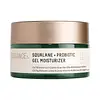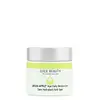What's inside
What's inside
 Key Ingredients
Key Ingredients

 Benefits
Benefits

 Concerns
Concerns

 Ingredients Side-by-side
Ingredients Side-by-side

Water
Skin ConditioningGlycerin
HumectantSqualane
EmollientLepidium Sativum Sprout Extract
Skin ConditioningSodium Acrylates Copolymer
Caprylic/Capric Triglyceride
MaskingBisabolol
MaskingPhospholipids
Skin ConditioningHansenula/Kloeckera/Lactobacillus/Lactococcus/Leuconostoc/Pediococcus/Saccharomyces/Fig/Lemon Ferment
Skin ConditioningSodium Hyaluronate
HumectantChondrus Crispus Extract
Skin ConditioningAllantoin
Skin ConditioningGlycine Soja Sterols
EmollientLinoleic Acid
CleansingCapryloyl Glycerin/Sebacic Acid Copolymer
Skin ConditioningDiheptyl Succinate
EmollientCellulose Gum
Emulsion StabilisingLecithin
EmollientSorbitan Oleate
EmulsifyingIsoeicosane
EmollientChitosan
Sodium Phytate
Caprylyl Glycol
EmollientPhenoxyethanol
Preservative1,2-Hexanediol
Skin ConditioningCitric Acid
BufferingWater, Glycerin, Squalane, Lepidium Sativum Sprout Extract, Sodium Acrylates Copolymer, Caprylic/Capric Triglyceride, Bisabolol, Phospholipids, Hansenula/Kloeckera/Lactobacillus/Lactococcus/Leuconostoc/Pediococcus/Saccharomyces/Fig/Lemon Ferment, Sodium Hyaluronate, Chondrus Crispus Extract, Allantoin, Glycine Soja Sterols, Linoleic Acid, Capryloyl Glycerin/Sebacic Acid Copolymer, Diheptyl Succinate, Cellulose Gum, Lecithin, Sorbitan Oleate, Isoeicosane, Chitosan, Sodium Phytate, Caprylyl Glycol, Phenoxyethanol, 1,2-Hexanediol, Citric Acid
Aloe Barbadensis Leaf Juice
Skin ConditioningCaprylic/Capric Triglyceride
MaskingGlyceryl Stearate
EmollientHelianthus Annuus Seed Oil
EmollientGlycerin
HumectantStearyl Alcohol
EmollientCetyl Alcohol
EmollientMyristyl Myristate
EmollientGlyceryl Stearate Citrate
EmollientSimmondsia Chinensis Seed Oil
EmollientSqualane
EmollientCaprylyl Glycol
EmollientPyrus Malus Juice
Skin ConditioningVitis Vinifera Juice
AntioxidantCitrus Limon Juice
Skin ConditioningButyrospermum Parkii Butter
Skin ConditioningCarthamus Tinctorius Seed Oil
MaskingPalmitoyl Tripeptide-5
Skin ConditioningBorago Officinalis Seed Oil
EmollientCamellia Sinensis Leaf Extract
AntimicrobialMagnesium Ascorbyl Phosphate
AntioxidantXanthan Gum
EmulsifyingAlgae Extract
EmollientPersea Gratissima Oil
Skin ConditioningUbiquinone
AntioxidantOenothera Biennis Oil
EmollientAllantoin
Skin ConditioningSalix Alba Bark Extract
AstringentPanthenol
Skin ConditioningLinum Usitatissimum Seed Oil
PerfumingHyaluronic Acid
HumectantLonicera Caprifolium Extract
AstringentLonicera Japonica Callus Extract
Skin ProtectingSaccharum Officinarum Extract
MoisturisingThioctic Acid
AntioxidantTocopherol
AntioxidantCitrus Aurantium Dulcis Oil
MaskingCinnamomum Camphora Bark Oil
MaskingLitsea Cubeba Fruit Oil
MaskingEthyl Linalool
MaskingCitral
PerfumingLimonene
PerfumingGeraniol
PerfumingAloe Barbadensis Leaf Juice, Caprylic/Capric Triglyceride, Glyceryl Stearate, Helianthus Annuus Seed Oil, Glycerin, Stearyl Alcohol, Cetyl Alcohol, Myristyl Myristate, Glyceryl Stearate Citrate, Simmondsia Chinensis Seed Oil, Squalane, Caprylyl Glycol, Pyrus Malus Juice, Vitis Vinifera Juice, Citrus Limon Juice, Butyrospermum Parkii Butter, Carthamus Tinctorius Seed Oil, Palmitoyl Tripeptide-5, Borago Officinalis Seed Oil, Camellia Sinensis Leaf Extract, Magnesium Ascorbyl Phosphate, Xanthan Gum, Algae Extract, Persea Gratissima Oil, Ubiquinone, Oenothera Biennis Oil, Allantoin, Salix Alba Bark Extract, Panthenol, Linum Usitatissimum Seed Oil, Hyaluronic Acid, Lonicera Caprifolium Extract, Lonicera Japonica Callus Extract, Saccharum Officinarum Extract, Thioctic Acid, Tocopherol, Citrus Aurantium Dulcis Oil, Cinnamomum Camphora Bark Oil, Litsea Cubeba Fruit Oil, Ethyl Linalool, Citral, Limonene, Geraniol
 Reviews
Reviews

Ingredients Explained
These ingredients are found in both products.
Ingredients higher up in an ingredient list are typically present in a larger amount.
Allantoin is a soothing ingredient known for its protective and moisturizingg properties. Because of this, it is often added to products with strong active ingredients.
Studies show higher concentrations of this ingredient can promote wound healing.
Though it can be derived from the comfrey plant, allantoin is produced synthetically for cosmetic products to ensure purity.
Learn more about AllantoinThis ingredient is an emollient, solvent, and texture enhancer. It is considered a skin-softener by helping the skin prevent moisture loss.
It helps thicken a product's formula and makes it easier to spread by dissolving clumping compounds.
Caprylic Triglyceride is made by combining glycerin with coconut oil, forming a clear liquid.
While there is an assumption Caprylic Triglyceride can clog pores due to it being derived from coconut oil, there is no research supporting this.
Learn more about Caprylic/Capric TriglycerideCaprylyl Glycol is a humectant and emollient, meaning it attracts and preserves moisture.
It is a common ingredient in many products, especially those designed to hydrate skin. The primary benefits are retaining moisture, skin softening, and promoting a healthy skin barrier.
Though Caprylyl Glycol is an alcohol derived from fatty acids, it is not the kind that can dry out skin.
This ingredient is also used as a preservative to extend the life of products. It has slight antimicrobial properties.
Learn more about Caprylyl GlycolGlycerin is already naturally found in your skin. It helps moisturize and protect your skin.
A study from 2016 found glycerin to be more effective as a humectant than AHAs and hyaluronic acid.
As a humectant, it helps the skin stay hydrated by pulling moisture to your skin. The low molecular weight of glycerin allows it to pull moisture into the deeper layers of your skin.
Hydrated skin improves your skin barrier; Your skin barrier helps protect against irritants and bacteria.
Glycerin has also been found to have antimicrobial and antiviral properties. Due to these properties, glycerin is often used in wound and burn treatments.
In cosmetics, glycerin is usually derived from plants such as soybean or palm. However, it can also be sourced from animals, such as tallow or animal fat.
This ingredient is organic, colorless, odorless, and non-toxic.
Glycerin is the name for this ingredient in American English. British English uses Glycerol/Glycerine.
Learn more about GlycerinSqualane is an emollient that helps the skin hold onto moisture. It's an oily liquid that occurs naturally in certain types of fish and plant oils.
Because squalane boosts hydration in the skin, it also comes with plenty of benefits: it is an antioxidant and can help fight free radicals and skin damage. Squalane is also found to have a detoxifying effect when applied.
Squalane comes from squalene, which occurs naturally within the sebum of our skin. It is one of the oils our skin produces to keep itself hydrated. Squalane is the hydrogenated version of squalene and has a longer shelf life.
Research shows that squalane is non-irritating (even at 100% concentration).
In general, it's a fantastic ingredient. It does a great job at hydrating the skin, and it's suitable for those with sensitive skin.
The source of squalane may impact malassezia / fungal acne. This is because olive oil derived squalane can contain impurities such as fatty acids and plant waxes. Sugarcane derived squalane is recommended for anyone with malassezia concerns.
Is squalane vegan?
This depends on the source. Squalane can be derived from both plants and animals. Most squalane used in skincare comes from plants.
Please note: the source of squalane is only known if disclosed by the brand. We recommend reaching out to the brand if you have any questions about their squalane.
Read more about squalene with an "e".
Is squalane an oil?
Squalane is often called an oil, but it’s technically not; it’s a hydrocarbon, meaning it’s only made of carbon and hydrogen, unlike true oils which are triglycerides made of fatty acids and glycerol.
The term “oil-free” isn’t regulated, so companies can define it however they want. Some exclude all oils, while others just avoid mineral oil or comedogenic oils.
While some people avoid oils thinking they cause breakouts, the right kind of oil (or oil-like ingredient like squalane) can actually help balance and hydrate your skin. It’s worth testing out simple oils or squalane to see what works best for your skin.
Learn more about Squalane